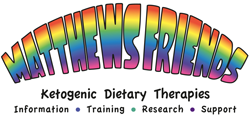Ketogenic therapy: Preparation and initiation
Commitment to the initial three months
Ketogenic therapy is an experimental journey with the individual treatment path evolving over months. The first few weeks are generally the most challenging in that you are learning to cope with significant changes in meal planning, shopping for new foods, measuring food portions and altering cooking methods. In addition, there is the responsibility for monitoring and recording seizure and symptom changes and frequent feedback to your ketogenic team. Although the whole process becomes more familiar and easier over time, in the early weeks, it can seem like there is little time to do anything else other than simply manage the therapy. For this reason, it is important that the trial occurs when home life is relatively stable and you are able to give it your best attention. Your ketogenic team will ensure that medication adjustments are managed before starting so that the only variable to change during the trial period is the food choice.
Thorough preparation, careful initiation, meticulous monitoring and close working with your ketogenic team are essential to give this therapy its best chance to work.
Preparation; food (4- 8 weeks before starting a prescribed regime)
Once the pre-ketogenic neurological and biochemical screening has been carried out and you have agreed a possible time frame for starting ketogenic therapy, the preparations need to start. You will attend a training session with your ketogenic team and your food records, food preferences and normal patterns of eating will be used as a basis to advise on how the ketogenic diet will be structured and what you may do in preparation for this.
Common step changes are as follows:
- Maintaining a regular meal & snack routine, becoming aware of portion control and ensuring that all food is eaten. It is also very important to evolve a strategy to manage any feeding related behavioural issues, before commencing ketogenic therapy.
- Cutting out sugar, sweets, chocolates, cakes & biscuits.
It is a good idea to look for alternative options and reduce the dependency on sweet foods BEFORE starting the ketogenic diet.
- Increasing the fats and oils in meals.
You may be advised to start using full fat (not low fat) products and trying out ways of increasing the amounts of fats and oils (olive oil, coconut oil, butter, mayonnaise, double cream etc) added into meals
- Trying out a few ketogenic recipes
You may also be provided with a few menu ideas and recipes that you can try out, just to see what works best in your situation. These can help to build your confidence before the start.
Preparation; people
It is so very important to talk to family, friends and any carers (teachers, tutors, support workers) who are involved in any way with providing, sharing or supervising meals, even though it may only be occasional. Everyone needs to be on board and understand that this ‘diet‘ is not a whim, but a medical therapy; an anticonvulsant medication that just happens to be delivered in the form of food. As such, all food and drink needs to meet the requirements of the individual diet prescription. A kindly chocolate ‘treat’ from a well-meaning carer, a fruit bowl or a biscuit left unattended at a child’s grab height or are all the sorts of commonplace situations that can lead to destabilisation of the ketogenic change and a possible increase in seizures.
You generally get one shot at this initial trial, so it is best that everyone is on board, asking questions and understanding the principles before you start, rather than leaving things to chance and putting the outcome of the trial period at risk.
Initiation
Traditionally, ketogenic regimes were started with an admission to hospital for a period of water only fasting (12-72 hours) followed by a gradual introduction of ketogenic meals. However, it has been shown that fasting is not necessary to achieve ketosis and a more gradual introduction process can produce the same seizure control at 3 months with a significantly lower frequency of initiation related side effects such as vomiting, dehydration, acidosis and rapid weight loss requiring medical intervention(1).
In the UK, ketogenic treatment is generally initiated at home, (unless under the age of 1 year or very unwell and already in hospital), with no fasting stage and a gradual introduction of ketogenic meals over 4-5 days or up to 10 days if the MCT version is being used. During the transition phase it is normal to feel lethargic, weak or even dizzy and nauseous while the body adapts to the lower availability of carbohydrate and the need to burn fats as the primary fuel. Some may experience episodes of low blood glucose or high ketones and occasionally vomiting or an increase in seizures. It is a good idea to limit outside commitments and take things easy over these initial days and keep in close contact with your ketogenic support team.
References
- Bergqvist AG, Schall JI, Gallagher PR, Cnaan A, Stallings VA. Fasting versus gradual initiation of the ketogenic diet: a prospective, randomized clinical trial of efficacy. Epilepsia. 2005 Nov;46 (11):1810-9.




